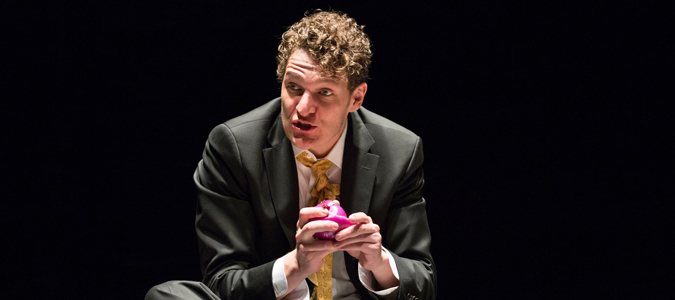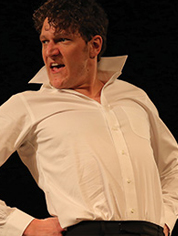

Peer Gynt
Opening Night: May 25, 2016
Closing: June 19, 2016
Theater: Classic Stage Comp.
Director John Doyle (Passion, Allegro) brings to the stage his own adaptation of Ibsen’s tale of the misadventures of Peer Gynt. Follow young Peer from childhood renegade to outcast, adventurer, industrialist and provocateur as he searches for a life that will live up to his impossible and irrepressible expectations.
BUY TICKETSREAD THE REVIEWS:
May 25, 2016
Toward the end of Ibsen’s “Peer Gynt,” a saga of self under siege, the title character is discovered peeling an onion, finding in the layers of that humble vegetable a symbol for the chapters of an eventful life. In most productions of this bulky fantasia, the moment is a long time coming — as much as five or six hours — and audiences are likely to feel as depleted as the now aged Peer. But in John Doyle’s bare-boned adaptation of “Peer Gynt,” which opened on Wednesday night at the Classic Stage Company, the dialogue between man and onion arrives after a mere 100 minutes or so. The onion is definitely real and definitely itself, one of the few items in this scenery-free production of which this might be said. As for the man, though he’s embodied in the sullied flesh by the talented Gabriel Ebert, his identity is, as always, open to debate. So, come to think of it, is that of the strange and swirling play in which he appears, though in this telling “Peer Gynt” is both more digestible and less flavorful than usual. Mr. Doyle, whose similarly minimalist version of the musical “The Color Purple” is one of the triumphs of the recently concluded Broadway season, has here done his imaginative best to tame, through shrinkage, one of the great, shape-shifting monsters of world theater. (Mr. Doyle is the newly anointed artistic director of the Classic Stage Company, and you can imagine this valuable institution will be saving a fortune on production budgets.) Originally composed in five acts of verse that travel the globe amid various real and surreal estate, this early work by Ibsen would seem to have little in common with his later, better-known dramas of scalding social realism, “Ghosts” and “A Doll’s House.” Yet in some ways, “Peer Gynt,” inspired by Norwegian folk tales, is the most prophetically modern of all his plays, anticipating writers of the page (Joyce, Kafka) and stage (Ionesco, Pirandello) who would question the very nature of reality and identity. Writing in The New York Times in 1969, the great critic Walter Kerr observed: “We have, at this particular time in our theatrical history, caught up with ‘Peer Gynt,’ above all with what used to seem its stylistic contrariness. This is the kind of play we know now, breathe now, live with now.” That production, staged in Central Park by Gerald Freedman, was said to be a sprawling eyeful, replete with grotesque visions out of Hieronymus Bosch, appropriate to a play that conspicuously features trolls (of the pre-Internet variety). “Peer Gynt” has since attracted directors of ripe imagistic bent, including Ingmar Bergman and, more recently, Robert Wilson. Mr. Doyle (who also did the compellingly skeletal 2005 Broadway revival of “Sweeney Todd”) doesn’t do spectacle. His approach is the same one that Peer applies to the onion: Keep stripping until you find the core. Of course in Peer’s case what is finally found is plenty of nothing, an apt conclusion for a man for whom a solid self remains elusive. Mr. Doyle’s six-performer, single-set, intermission-free condensation delivers somewhat more fruitful results. If this production lacks the teeming, motley exuberance that pulses in Ibsen’s text, it definitely distills the intriguing philosophical essence of a play that still seems unsettlingly relevant. And you may wind up filling in the blanks left by Mr. Doyle’s stark staging with contemporary scenes from, among other sources, the current presidential race. Like your typical American politician, our Peer, played with radiant petulance and inexhaustible athleticism by Mr. Ebert, is a figure of great bluster, ambition and duplicity. We first meet him as a boy telling his impoverished, understandably distrustful Mother (Becky Ann Baker) extravagantly tall tales of riding an enchanted stag through the mountain. Someday, he says, he’s going to be emperor. And in the scenes that follow, he makes good on the boast, as he roams from the mazelike, snowy forests of Norway to the boundless sea, with stops in the New World and the North African desert. He becomes, among other things, a prince in the realm of the trolls; a millionaire slave trader (“I wanted to stimulate the economy,” he explains); and a seducer and abandoner of assorted women. At the same time, he never stops wondering what personality has been shaped by this nomadic life. “Man, be thyself,” goes an injunction oft-repeated in the play. But who is that? As he contemplates his imminent death, Peer broods, “Then let the snow fall over me and on my resting place may they write — ‘Here Lies No One.’” I’m making “Peer Gynt,” a work of endless contradictions, sound simpler than it is. Every assertion is followed by its opposite. And the figures who bedevil Peer include, in addition to the trolls he takes up with (embodied by Dylan Baker and Jane Pfitsch), a mysterious stranger on a doomed ship (George Abud); a cosmic button molder (Adam Heller); and Solveig (a touching Quincy Tyler Bernstine), Peer’s pure-hearted, ever-waiting sweetheart. WRITE A COMMENT Their diverse interactions — hauntingly underscored by Dan Moses Schreier’s music and sound design — occur on and around a ragged raised platform of a stage (David L. Arsenault did the set). But it’s a small space, basically built for one, and it seems safe to say Peer has seldom seemed as solitary a soul as he does here. By the time he comes to his tête-à-tête with the onion, we may not feel like weeping, as Peer does (it’s an onion, remember). But in this production, we can definitely understand why and how he’s reached this pathetic moment of communion.
READ THE REVIEW


















